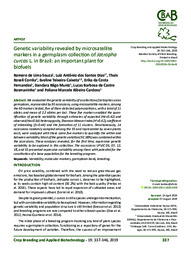Genetic variability revealed by microsatellite markers in a germplasm collection of Jatropha curcas L. in Brazil: an important plant for biofuels.
Genetic variability revealed by microsatellite markers in a germplasm collection of Jatropha curcas L. in Brazil: an important plant for biofuels.
Author(s): SOUZA, R. de L.; DIAS, L. A. dos S.; CORRÊA, T. R.; CAIXETA, E. T.; FERNANDES, E. da C.; MUNIZ, D. R.; ROSMANINHO, L. B. de C.; CARDOSO, P. M. R.
Summary: We evaluated the genetic variability of a collection of Jatropha curcas germplasm, represented by 93 accessions, using microsatellite markers. Among the 60 markers tested, five of them detected polymorphisms, with a total of 11 alleles and mean of 2.2 alleles per loci. These five markers enabled the quan-tification of genetic variability through estimates of expected (He=0.42) and observed (Ho=0.64) heterozygosity, Shannon-Weaver index (H?=0.62), coefficient of inbreeding (?=-0.44) and the formation of 11 clusters. Simultaneously, 14 accessions randomly sampled among the 93 and represented by seven plants each, were analyzed with these same five markers to quantify the within and between variability. Most of the genetic variation (92.58%) was contained within the accessions. These analyses revealed, for the first time, expressive genetic variability to be explored in this collection. The accessions UFVJC 05, 07, 12, 18, and 53 presented expressive variability among them with potential for the constitution of a base population for the breeding program.
Publication year: 2019
Types of publication: Journal article
Unit: Embrapa Coffee
Keywords: Biofuel, Breeding, Germplasm bank, Jatropha Curcas, Molecular marker, Variability
Observation
Some of Embrapa's publications are published as ePub files. To read them, use or download one of the following free software options to your computer or mobile device. Android: Google Play Books; IOS: iBooks; Windows and Linux: Calibre.
Access other publications
Access the Agricultural Research Database (BDPA) to consult Embrapa's full library collection and records.
Visit Embrapa Bookstore to purchase books and other publications sold by Embrapa.

